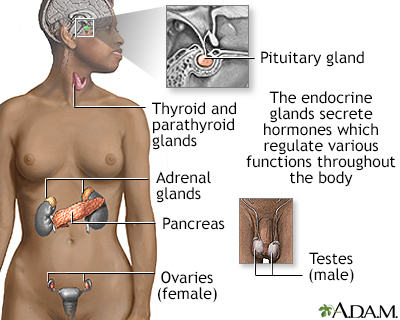Acromegaly
Definition
Acromegaly is a condition in which there is too much growth hormone (GH) in the body.
Alternative Names
Somatotroph adenoma; Growth hormone excess; Growth hormone secreting pituitary adenoma; Pituitary giant (in childhood)
Causes
Acromegaly is a rare condition. It is caused when the pituitary gland makes too much growth hormone. The pituitary gland is a small endocrine gland attached to the bottom of the brain. It controls, makes, and releases several hormones, including growth hormone.
Usually, a noncancerous (benign) tumor of the pituitary gland releases too much growth hormone. In rare cases, pituitary tumors can be inherited.
In children, too much GH causes gigantism rather than acromegaly.
Symptoms
Symptoms of acromegaly may include any of the following:
- Body odor
- Blood in the stool
- Carpal tunnel syndrome
- Decreased muscle strength (weakness)
- Decreased peripheral vision
- Dental problems, gaps between the teeth
- Easy fatigue
- Enlarged tongue
- Excessive height (when excess GH production begins in childhood)
- Excessive sweating
- Headache
- Heart enlargement, which can cause fainting
- Hoarseness
- Jaw pain
- Joint pain, limited joint movement, swelling of the bony areas around a joint
- Large bones of the face, large jaw and tongue, widely spaced teeth
- Large feet (change in shoe size), large hands (change in ring or glove size)
- Large glands in the skin (sebaceous glands) causing oily skin, thickening of the skin, skin tags (growths)
- Sleep apnea
- Widened fingers or toes, with swelling, redness, and pain
Other symptoms that may occur with this disease:
- Colon polyps
- Excess hair growth in females (hirsutism)
- High blood pressure
- Type 2 diabetes
- Thyroid enlargement
- Weight gain
Exams and Tests
The health care provider will perform a physical exam and ask about your symptoms.
The following tests may be ordered to confirm the diagnosis of acromegaly and check for complications:
- Blood glucose
- Growth hormone
- Insulin-like growth factor 1 (IGF-1)
- Prolactin
- Spine x-ray
- MRI of the brain, including the pituitary gland
- Echocardiogram
- Colonoscopy
- Sleep study
Other tests may be ordered to check whether the rest of the pituitary gland is working normally.
Often a growth hormone suppression test is needed. This involves drawing blood from a vein 4 or 5 times over 2 hours before and after drinking a specific amount of a sugar solution. Glucose and GH are measured in the blood.
Treatment
Surgery to remove the pituitary tumor that is causing this condition often corrects the abnormal GH. Sometimes, the tumor is too large to be removed completely and acromegaly is not cured. In this case, medicines and radiation (radiotherapy) may be used to treat acromegaly.
Some people with tumors that are too complicated to remove by surgery are treated with medicines instead of surgery. These medicines may block the production of GH from the pituitary gland or prevent the action of GH in other parts of the body.
After treatment, you will need to see your provider regularly to make sure that the pituitary gland is working normally and that acromegaly does not come back. Yearly evaluations are recommended.
Support Groups
More information and support for people with acromegaly and their families can be found at:
- National Institute of Diabetes and Digestive and Kidney Diseases -- www.niddk.nih.gov/health-information/endocrine-diseases/acromegaly
- National Organization for Rare Disorders -- rarediseases.org/rare-diseases/acromegaly/
Outlook (Prognosis)
Pituitary surgery is successful in most people, depending on the size of the tumor and the experience of the neurosurgeon with pituitary tumors.
Without treatment, the symptoms will get worse. Conditions such as high blood pressure, diabetes, and heart disease may result.
When to Contact a Medical Professional
Call your provider if:
- You have symptoms of acromegaly
- Your symptoms do not improve with treatment
Prevention
Acromegaly cannot be prevented. Early treatment may prevent the disease from getting worse and help to avoid complications.
Gallery

References
James WD, Elston DM, Treat JR, Rosenbach MA, Neuhaus IM. Endocrine diseases. In: James WD, Elston DM, Treat JR, Rosenbach MA, Neuhaus IM, eds. Andrews' Diseases of the Skin: Clinical Dermatology. 13th ed. Philadelphia, PA: Elsevier; 2020:chap 24.
Katznelson L, Laws ER Jr, Melmed S, et al. Acromegaly: an endocrine society clinical practice guideline. J Clin Endocrinol Metab. 2014;99(11):3933-3951. PMID: 25356808 pubmed.ncbi.nlm.nih.gov/25356808/.
Klein I, Biondi B. Endocrine disorders and cardiovascular disease. In: Zipes DP, Libby P, Bonow RO, Mann DL, Tomaselli GF, Braunwald E, eds. Braunwald's Heart Disease: A Textbook of Cardiovascular Medicine. 11th ed. Philadelphia, PA: Elsevier; 2019:chap 92.
Melmed S. Acromegaly. In: Jameson JL, De Groot LJ, de Kretser DM, et al, eds. Endocrinology: Adult and Pediatric. 7th ed. Philadelphia, PA: Elsevier Saunders; 2016:chap 12.
